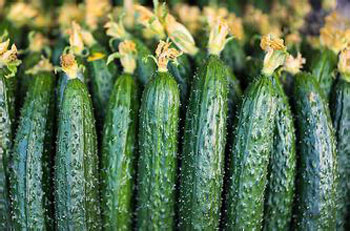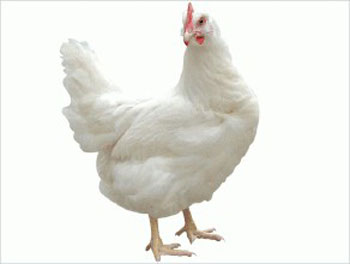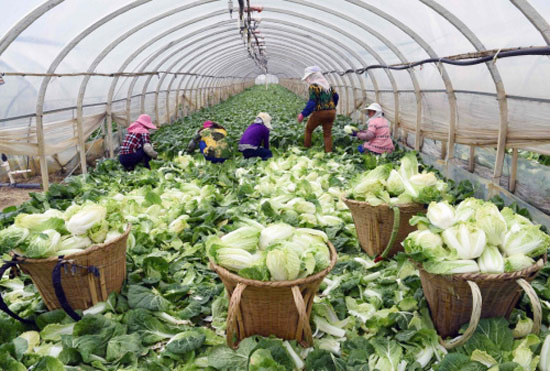Cucumber with thorns on the top flower: please rest assured that credit
Is the cucumber with thorns poisonous?

Recently, the reporter came across such a scene in a vegetable market in Beijing: a customer pointed a prickly cucumber at the vegetable vendor and said on Wechat that this kind of cucumber was "poisonous"! Caused passers-by to stop one after another, vegetable vendors disobeyed: why do you say so? The customer said, why don't these flowers thank you? It's all caused by hormones, and the ingredients of hormones are the same as contraceptive.
The "top flower with thorn" of some cucumbers is a natural phenomenon.
"have cucumbers really used hormones?" The answer is: some cucumbers are actually used.
"so, are agricultural products that have used plant hormones safe after all?" The answer is: safe.
Researcher Wang Qiang, director of the Institute of Agricultural products quality Standards of Zhejiang Academy of Agricultural Sciences, member of the expert Group on Agricultural products quality and Safety of the Ministry of Agriculture, and Director of the Agricultural products quality and Safety risk Assessment Laboratory (Hangzhou) of the Ministry of Agriculture, responded that the "contraceptive cucumber" is pure rumor. Contraceptive is an animal hormone, which has no effect on the growth and development of plant cucumber, so it is impossible to use it on cucumber. Because the plant growth regulators used on cucumber can promote the growth and development of cucumber, it has the role of hormone, and contraceptive is also a hormone. As a result, it was passed around, and finally it was spread to cucumbers using contraceptive.
According to Dr. Zhong Kai of the National Food Safety risk Assessment Center, the "top flower with thorn" cucumber is parthenocarpy, is an inherent biological characteristic, and there is no safety risk. Cucumber flowers are basically monoecious, with occasional bisexual flowers. The cucumber fruit is a false fruit, which is formed by the combination of the ovary and the receptacle. Cucumbers can bear fruit without pollination and fertilization, which is called parthenocarpy, thus giving rise to cucumbers with spines at the top. When cucumber was cultivated in protected field in winter and spring, cucumber plant growth was weak and slow due to the influence of low temperature, short day light and weak light. Under the condition of low temperature and short day, cucumber has a large number of female flowers and low fruit setting rate, which affects cucumber yield. therefore, the flower stalk is often smeared with 50 mg / L chloropyruron solution on the day of flowering or the day before flowering, in order to increase the fruit setting rate and increase the yield.
Zhong Kai pointed out: the "top flower with thorns" cucumbers produced in winter and spring are partly caused by the natural unisexual fruiting of cucumbers, and some are caused by the unisexual fruiting of cucumbers produced by the use of chloropyruril, which is not caused by the legendary use of "contraceptive".
In addition to the rumors of contraceptive cucumbers, popular posts such as "straight cucumbers are sprayed, curved cucumbers are natural" and "cucumbers buy bends, leeks are short" and so on.
"straight cucumber and curved cucumber can be grown and formed under natural conditions. The growth condition determines the proportion of cucumber bending and straightening, and so does the variety. " Yu Xianchang, chief scientist of the vegetable cultivation and physiological science and technology innovation team of the Chinese Academy of Agricultural Sciences, said that generally speaking, straight cucumbers are normal.
Yu Xianchang said: "in the early stage of poor plant growth environment, poor temperature and light conditions, poor plant growth, or late plant premature senescence, applying appropriate concentration of chloropyruron on cucumber flowers can improve fruit growth. It can also reduce the proportion of curved cucumbers and increase the yield and commercial value of cucumbers. The normal use of clopiramide is harmless to the human body. "
Plant growth regulators are widely used all over the world.
So what exactly is what experts call clopirazide? It's actually a plant growth regulator.
According to Wang Qiang, plant growth regulators are a kind of agricultural inputs that can regulate and control plant growth and development, which are produced by artificial synthesis or through microbial fermentation, and can also be extracted directly from plants, commonly known as plant hormones. It is completely different from animal hormones and has no effect on human growth and development.
Wang Qiang further explained that hormones are essential to the normal growth and development of organisms, and the lack of hormones or insufficient hormones will directly affect the normal growth and development of organisms. Plant hormones play a role in plants, and animal hormones regulate the growth and development of animals. The targets and mechanisms of the two are completely different. Plant growth regulator is also called plant exogenous hormone, its effect is the same or similar to the plant endogenous hormone produced by the plant itself, but it is completely different from animal hormone and has no effect on human growth and development.
Wang Qiang said that as a technical measure of high-yield, high-quality and high-efficiency agriculture, plant growth regulators have been widely used all over the world. Including the United States, European Union, Japan and other developed countries, at present, there are more than 40 kinds of plant growth regulators in the world, such as ethephon, gibberellic acid, naphthylacetic acid, indolebutyric acid, paclobutrazol, dwarf and so on. It is mainly used in fruits, vegetables, potatoes, soybeans and other crops. For example, the European Union has registered 26 active ingredients and 197 preparation products, allowing these plant growth regulators to be used on crops within the registered range.
Wang Qiang said: plant growth regulators can promote or inhibit the growth or fruit ripening of stems, leaves, roots, buds and flowers, protect flowers and fruits, advance or prolong dormancy, and promote fruit growth. to achieve the purpose of increasing yield, improving quality, and promoting ripening, so some agricultural products need to use plant growth regulators in the production process to achieve their best production effect and nutritional quality performance. For example, the use of paclobutrazol in wheat can prevent lodging; the application of gibberellin in pear trees can reduce the drop of flowers and fruits caused by temperature, nutrition, vector insects and other reasons, and increase the fruit setting rate; treating potatoes with chloraniline can inhibit germination and avoid alkaloid poisoning.
In agricultural production, most crops can rely on their own plant endogenous hormone activities, and through varieties, cultivation, fertilization, pest prevention and other measures to achieve the goal of high yield and high quality. Plant growth regulators are used only when a very small number of plant endogenous hormones are insufficient to regulate and control plant expected growth and development, so not all agricultural products need to use plant growth regulators.
There have been no cases of food poisoning caused by the use of plant growth regulators.
Wang Qiang said that compared with other pesticides, although plant growth regulators are included in the category of pesticide management, they are not traditional pesticides for disease prevention, pest control, and weed control. Their products are of low micro-toxicity, use is very small, and products are safe. After the use of plant growth regulators, some residues will be formed in agricultural products more or less. However, compared with other pesticides, the residues of plant growth regulators in agricultural products are very small and degraded rapidly. they are all used in flowering and early fruit-setting stage, and the interval between harvest is longer, and the residues in mature and harvest agricultural products are generally very low. even if there are residues in individual products, they are very small. At present, the monitoring of plant growth regulator residues is good, no samples with excessive residues are found in market monitoring, and the listed products meet the requirements of national food safety standards.
Wang Qiang said: from the monitoring and evaluation of plant growth regulator residues in agricultural products by the Ministry of Agriculture, the samples with plant growth regulators residual in agricultural products during the harvest period are only very few, and even if they are detected in individual cases, the residual value is also very low, almost undetectable, far lower than the national standard residue limit for food safety. No samples with excessive residues were found in the market monitoring, which all met the national statutory food safety requirements. Internationally, there have been no food safety incidents related to plant growth regulator residues. (our reporter Gao Wen)
- Prev

The infinite possibility for eggs to get rich lies in tossing about.
The infinite possibility for eggs to get rich lies in tossing about.
- Next

Vegetables from Yunnan plateau are popular in Beijing, Guangzhou and Shenzhen.
Vegetables from Yunnan plateau are popular in Beijing, Guangzhou and Shenzhen.
Related
- A course of planting techniques and methods on how to grow carrots
- How to plant the latest tulips?
- Is it better to pick tea in the morning or in the afternoon? When is the best time for tea to be picked? what is the third or fifth tea?
- Launch Yuanxiao Happy combination Haocha + Tea Yuan healthy Taste
- Penghu Tourism "Fireworks 20 Parade with You"
- 2022 West Lake Happiness holds "Digital Revitalization Voucher" and draws iphone13 and laptop.
- Banqiao Fuzhou social houses are designed to change start-up combined with police elimination to create a safe and livable environment
- The convenient measure of "mechanical weeding" in Xinbei has been abused and the Agriculture Bureau has imposed heavy penalties on the illegal land consolidation.
- Changgeng University Joins Hands with Four Memory Factories to Rescue Memory Talent Shortage
- The list of Taiwan's top 100 MVP managers is listed by the Director-General of the Farmers' Association of Sanxia District.

